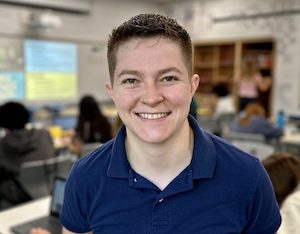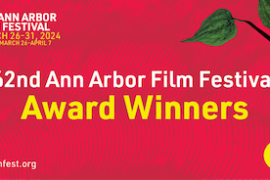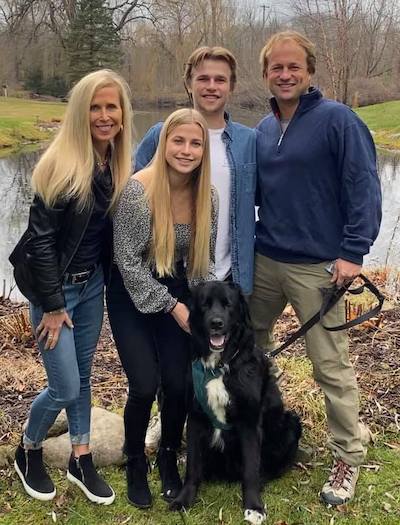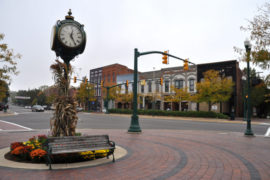Story and photos by Jo Mathis/AAPS District News Editor
Sasha Azanov grew up in Bucks County, Pennsylvania in a town called New Hope. She says the small, tight-knit community was a great place to grow up. Her parents immigrated from Russia in the early 1990s, so a lot of her values came from their experiences both in Russia and as immigrants to the US. After high school, Azanov came to Ann Arbor for undergrad and met her wife during their sophomore year of college. They decided to stay in the area after they graduated since they loved Ann Arbor so much.
Azanov spent her first four years as a teacher in the Wayne Westland Community School District and decided to move on to Tappan to be closer to home and teach in the community in which she lives. She and her wife have a beloved 14-year-old cat named Stanley.
Asked how they’re enjoying their social studies class with Azanov this year, three eighth graders responded enthusiastically.
“She makes everything that’s hard fun in a way,” said Daniel.
“Adding on to what Daniel says, she does make everything more fun and immersive, so we’re not just being taught at, we’re doing the things that we’re learning about,” said Hazel.
Krishika said that she didn’t have friends in the class at the start of the school year, but thanks to Azanov putting the class in groups to work together, that’s changed. “And I didn’t know anything about social science,” she said, “but I’m starting to understand and I really, really like it.”
What inspired you to become a social studies teacher, and what keeps you passionate about the subject?
I decided to be a social studies teacher after participating in a college internship called Breakthrough Collaborate. We spent three weeks learning the lesson planning process, as well as some classroom management basics, and then taught a summer program for middle school youth for six weeks. It was one of the most transformational experiences of my life, and I became interested in teaching as a way to lead youth in collectively imagining a more just, community-oriented, and humane future. Social studies felt like a great subject to facilitate that collective action, while studying how our past informs our present. I’m passionate about student advocacy and supporting students in their own journeys to understand how they can impact the world around them, as well as understanding their own identities and how they relate to our community and collective history. Hearing from students and their analysis, thoughts, and reflections about history and our current world keeps me passionate about the subject. I learn so much from my students and am consistently inspired by them.

How do you make history and social studies relevant and engaging for your middle school students?
I try to make social studies tangible and engaging to our students by creating lessons that are
as hands-on, kinesthetic, and related to our current world as possible. We connect historical
events and concepts to current events as well as their interests, and we complete creative projects that allow our students to make meaningful connections to the topics.
Can you share a particularly successful lesson or project that you’ve implemented in your classroom?
Students typically love the projects that we complete in social studies. Many of these were designed by amazing social studies teachers who started at Tappan before me, but some of them include creating multimedia advertisements to convince Paleolithic people to join the Neolithic Age, as well as creating “hominid superheroes.” We have solved detective cases using evidence to practice analyzing primary and secondary sources, and have analyzed pictures of Tappan in connection to Constitution Day. In American History, the students participate in simulations and skits that allow them to engage in critical thinking and dialogue with each other. In one particular lesson, students were debating which method of protest was most impactful, and ended up coming up with some really great reflections on the value
of working together as a community. Any time student voice, engagement, critical thinking, and even some fun is involved, I consider it a successful day!
What do you like about working at AAPS, and at Tappan in particular?
AAPS and Tappan are really wonderful places to work in and be in community with awesome
students, staff, and families. Tappan, in particular, has the most incredible community that is supportive, diverse, and inspiring. I’m so lucky to go to work at a place that makes me want to be better each day.
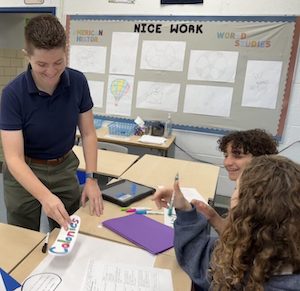 How do you differentiate instruction to meet the needs of students with varying learning styles
How do you differentiate instruction to meet the needs of students with varying learning styles
and abilities?
I try to provide a lot of choice and infuse lessons that tap into many different learning styles and modalities. We cover the same concept through kinesthetic lessons, creative projects, analyzing primary sources, videos, simulations, etc. Students are able to show what they’ve learned in ways that are meaningful and exciting to them, and I find that students are excited to come to class and learn when the content is presented in a way that gets them out of their seats or creatively showing what they’ve learned.
What are some of the most critical skills or values you aim to instill in your students through
social studies education?
Most importantly, I want our students to treat each other with dignity, respect, and understanding. We use historical empathy, reasoning skills, and habits of discussion to talk about complicated concepts while working on collaboration skills during group work, projects, and more. Additionally, it’s important for our students to be able to use critical thinking skills to understand the world around them.
How do you encourage critical thinking, discussion, and debate in the classroom?
We encourage critical thinking by evaluating primary and secondary sources in connection with a historical question, for example. These questions often ask students to compare their own thinking with someone else’s, which often leads to rich debate and discussion. We practice using evidence to support our claims in assignments, discussions, and reflections.
What do you enjoy doing in your free time, and how do you balance work and personal life?
In my free time, I love to cook, read, explore the outdoors, and spend quality time with my family and friends. I’m currently completing my last semester of graduate school, and prioritizing quality over quantity in both work and leisure has been a really good way to feel fulfilled in all areas of my life. I was taught a great mindset to have is to manage your energy, not your time. It helped me prioritize my well-being and take advantage of the moments where I did have more energy to complete work outside of the school day. I knew when I needed to prioritize rest or quality time with my loved ones, and it’s been a great way to maintain a work-life balance while managing many different things at the same time.
What’s your favorite book, movie, podcast, local restaurant?
My favorite books are “Remarkably Bright Creatures” by Shelby Van Pelt and “The One Hundred Years of Lenni and Margot” by Marianne Cronin. My favorite movie is Erin Brockovich, and my
favorite local restaurant is Detroit Filling Station.
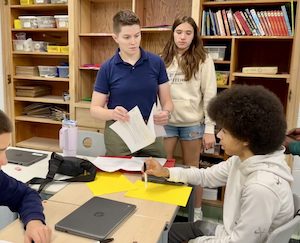
If you could travel anywhere in the world to explore a historical site or cultural phenomenon,
where would you go and why?
I’d really like to visit China and Japan, to explore so many of the ancient sites, architecture, and culture. I would also like to visit the archeological site, Catal Hoyuk, since we study images of what’s left of the Neolithic village in class. It would be amazing to see it in person.
What’s one thing you wish your students knew about you that might surprise them?
I spend a lot of time reflecting on our lessons and how to make them more engaging throughout the year. I also have way too many nicknames for my cat.
What are you most excited about right now?
I’m most excited about graduating in December with my master’s degree and getting to some of our really exciting lessons this year. There are also many milestone anniversaries and birthdays coming up in my family, so I’m looking forward to celebrating the amazing people in my life!
What’s the best advice you’ve ever received?
The best piece of advice I’ve ever received is to remember that everyone that you meet has something to teach you. I’ve tried to keep this mind as a teacher especially and lean into the incredible minds and hearts of my students and our classroom community. My colleagues at Tappan are some of the best, passionate, community-oriented, and engaging teachers and staff that I’ve worked with, and it’s an honor to be able to learn from and with them.

